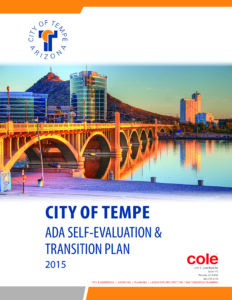Nationally-recognized ADA Transition Plan consultants
ADA TRANSITION PLANNING
For more than a decade, Cole’s ADA Self-Evaluation and Transition Planning experts have educated, guided, and led agencies of all sizes through a clear process to improve pedestrian accessibility in their communities.

Taking into account your budget and needs, our experts work with you to develop phased approaches that help mitigate short term risk while working towards full Self-Evaluation and Transition Plan compliance.
Assessing your programs, facilities, and policies for barriers that must be modified or removed in keeping with Title II of the Americans with Disabilities Act. Self-Evaluations form the basis for your agency’s ADA Transition Plan. Read our post on “How to Develop an ADA Transition Plan” for more details.
Our in-house developers and cutting edge ULIP-ADA technology combine to deliver the most accurate inventory and tracking of your assets. Customized tools ensure your data is immediately useable.
A customizable GIS interface and database integration that delivers actionable data to assist in ADA Transition Plan development, remediation, and long-term planning.
Building on your self-evaluation, our experts will help you update or create the right ADA Transition Plan for your agency and your needs. We will put you on the path to becoming compliant and support you all along the way.
From awareness of ADA to technical policies and standards, we can help your team gain the knowledge and information they need to successfully lead and implement ADA Transition plans.
An essential component of a successful ADA Transition Plan and process, engaging with the public and telling the story of your agency’s work is a key strength of our team. We can help you develop lines of communication, coordinate outreach, and create awareness.
Readiness Roadmap
A phased ADA Transition plan mitigates risk in the short-term
Creating a “living” ADA Transition plan, which can be continually updated, allows you to start where you are, assess your risk, and minimize its impact over time. Our Readiness Road Map helps you evaluate your current situation and set a course for the future of pedestrian access in the public rights-of-way in your community.
View Cole’s trusted Resources for ADA Transition Planning here.
1. Understand Where You Are
This critical initial step in creating an actionable ADA Transition Plan helps you assess your inventory, funding, existing asset management systems, and their shortcomings, as well as identify the people who must be involved to create a successful plan.
2. Understand Where You Need to Go
ADA Transition Planning is not a project, it is the beginning of a new program. A successful program must have leadership buy-in and support as well as practices and procedures that support the work.
3. Anticipate Common Pitfalls
Cole’s experience indicates that many agencies face similar issues in their ADA Self-Evaluation and Transition Planning in these areas: mindset, organization, project timeline, the implementation plan and the Transition Plan Report. Our experts help you navigate and plan to avoid some of these challenges.
4. Integrate Strategic Solutions
Creating a “living” ADA Transition Plan and understanding that you must begin with the end in mind helps you develop a sustainable plan. For each challenge there is an opportunity to strategically put your agency in the best possible position, while maximizing pedestrian accessibility.
5. Identify Suitable Technology & Systems
Cole’s ULIP-ADA technology reduces the time and labor costs associated with collecting sidewalk inventory, efficiently and precisely producing the data you need to make decisions.
Listen to our experts discuss their approach to ADA Self-Evaluation and Transition Plans

Steve Henze, ADAC, RAS
Director of Accessibility
Steve Henze
Steve possesses experience in the civil engineering design-transportation field and in the site development field. Steve is a Registered Accessibility Specialist (RAS), licensed by the State of Texas Department of Licensing and Regulation (TDLR). This is one of only two State certifications available in the United States and requires significant accessibility expertise to obtain. Steve has also received ACTCP certification - currently the only formal accessibility certification issued by the University of Missouri – Architectural Studies, College of Human Environmental Sciences and The Greater Plains ADA Center (ADAC).
Steve is responsible for managing ADA Self-Evaluation Plan projects from scope development to fully adopted Transition Plans, coordinating and managing the field collection crews, and training field personnel on PROW data collection. Steve is also responsible for monitoring the daily collection progress, addressing field crew questions, and assisting with QA/QC collected data.
ADA Project Map
US Map with ADA projects plotted and a list of the places the ADA team has worked below it.

Project Locations
Location: ipsum dolor sit amet, consectetur adipiscing elit, sed do.
Location: ipsum dolor sit amet, consectetur adipiscing elit, sed do.
Location: ipsum dolor sit amet, consectetur adipiscing elit, sed do.
Location: ipsum dolor sit amet, consectetur adipiscing elit, sed do.
Location: ipsum dolor sit amet, consectetur adipiscing elit, sed do.
Location: ipsum dolor sit amet, consectetur adipiscing elit, sed do.
Location: ipsum dolor sit amet, consectetur adipiscing elit, sed do.
Location: ipsum dolor sit amet, consectetur adipiscing elit, sed do.
Location: ipsum dolor sit amet, consectetur adipiscing elit, sed do.
Location: ipsum dolor sit amet, consectetur adipiscing elit, sed do.
Location: ipsum dolor sit amet, consectetur adipiscing elit, sed do.
Location: ipsum dolor sit amet, consectetur adipiscing elit, sed do.
Featured Projects











